May itinerary in Japan Day 2 (Kumamoto prefecture)
(Wednesday, May 18)
Table of contents
1. Shin-Yatsushiro Station / Yatsushiro Station
3. Former Gunchiku-Shinchi Kogo sluice gate
4. Yatsushiro Municipal Museum
6. Yatsushiro Castle Ruins / Yatsushiro-gu
9. Yatsushiro Shrine (Myoken shrine)
1. Shin-Yatsushiro Station / Yatsushiro Station
I moved from Hitoyoshi City to Yatsushiro City in the morning of May 18th (Wednesday). The transportation I used is as follows.
Depart Hitoyoshi IC at 9:54, highway bus “bound for Shin-Yatsushiro station”, arrive at Shin-Yatsushiro station at 10:34
Depart Shin-Yatsushiro Station at 10:46, Kagoshima Main Line “bound for Yatsushiro”, arrive at Yatsushiro station at 10:50, total fare Yen 1,590
At Shin-Yatsushiro Station, there is Kumamon with a fireworks shaku ball. Kumamon with this shaku ball is named after the “Yatsushiro National Fireworks Competition Festival“. The “Yatsushiro National Fireworks Competition Festival” is held in October every year.
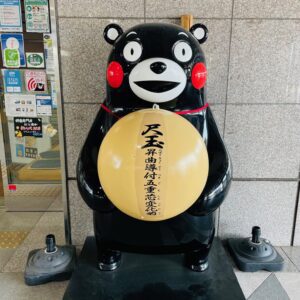
In Yatsushiro City, there are more than 100 Kumamon in the city. There is also a Kumamon map. I didn’t know in advance that there were so many Kumamon in Yatsushiro, but I did see so many Kumamon in the city. If you like Kumamon, please visit Yatsushiro.
There was Kumamon in front of Yatsushiro station. I thought it was Kumamon with a yellow ball, but the yellow ball is actually Banpeiyu (Citrus grandis). Banpeiyu is the largest citrus fruit in the world, which is a specialty of Yatsushiro.
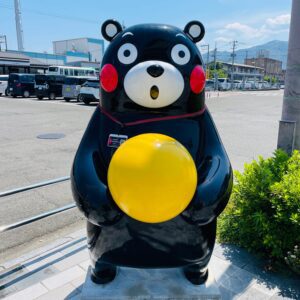
2. Kumamon Port Yatsushiro
After having an excellent lunch near Yatsushiro Station, I rented a bicycle and went to “Kumamon Port Yatsushiro“. It is about 9km from Yatsushiro Station to “Kumamon Port Yatsushiro“. It took about 40 minutes by bicycle.
The bicycle rental fee was as cheap as Yen 300 a day. Also, they took care of my luggage. The coin locker at Yatsushiro Station was Yen 400, so it’s cheaper to rent a bicycle and have my luggage stored.
“Kumamon Port Yatsushiro” was completed in March 2020 as a base for accepting international cruise ships. It was completed at the timing when the spread of the COVID-19 began, and it was the opening at the very worst timing. “Kumamon Port Yatsushiro” has a unique park with the theme of Kumamon as a place of relaxation for local residents. There are 84 Kumamon in “Kumamon Port Yatsushiro”.
“Kumamon Port Yatsushiro” is closed every Wednesday. I didn’t think there was a holiday because it was a park, so I went to “Kumamon Port Yatsushiro” by bicycle, but I couldn’t go inside because of the “closed day” sign.
It was a pity that the park was closed, but I was able to take a few pictures of Kumamon from the outside, so I will post a picture. I think “Kumamon Port Yatsushiro” is the best park for Kumamon lovers. Admission is free.
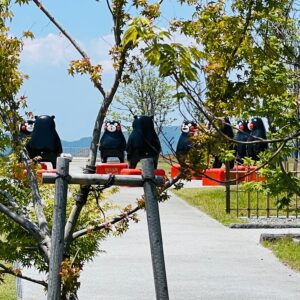
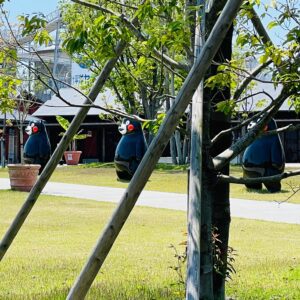
3. Former Gunchiku-Shinchi Kogo sluice gate
From “Kumamon Port Yatsushiro”, I went to “Former Gunchiku-Shinchi Kogo sluice gate”, which is a national important cultural property. The distance was about 2.5km and it took about 10 minutes by bicycle.
“Former Gunchiku-Shinchi Kogo sluice gate” is a sluice gate set up in the reclamation project “Gunchiku-Shinchi” and was built in 1900. The length of the sluice gate is 31.8m, and the width of the sluice gate is 8.3m.
To see the entire sluice gate from the side as shown in the first photo below, you have to go around a narrow farm road, which is difficult to access without a bicycle. It can be said that it is a difficult place to access on foot from “Kumamon Port Yatsushiro”.
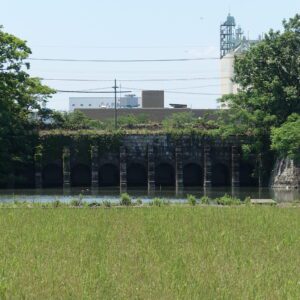
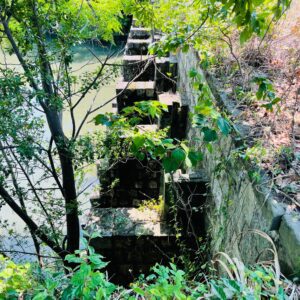
4. Yatsushiro Municipal Museum
After “Former Gunchiku-Shinchi Kogo sluice gate”, I went to “Yatsushiro Municipal Museum“. It took about 30 minutes by bicycle. I saw a cute Yatsushiro city circulation bus at the Sanko Bus Yatsushiro Sales Office on the way.
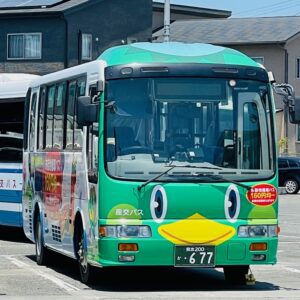
The “Yatsushiro Municipal Museum” was designed by world-famous architect Toyo Ito (US Pritzker Prize winner).
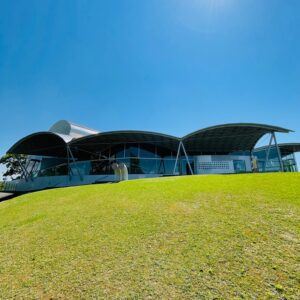
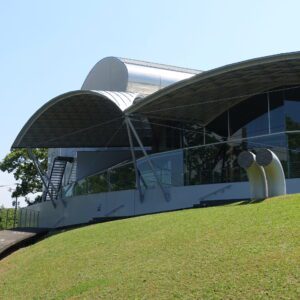
Admission: Yen 700 for adults, Yen 500 for high school students
I visited the “Matsumoto Performing Arts Centre” and “Shinmai Media Garden” designed by Toyo Ito in Matsumoto City, Nagano Prefecture two years ago, so I will post photos. Both are wonderful buildings.
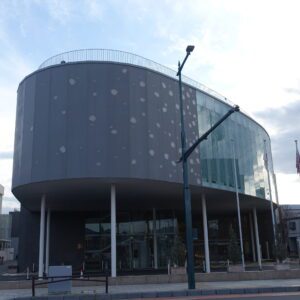
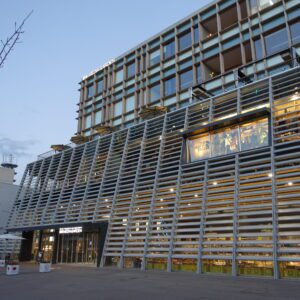
Kumamon wearing a mask stood in front of the “Yatsushiro Municipal Museum”. In addition, there was Kumamon with a book in the Yatsushiro City Library diagonally in front of the museum.

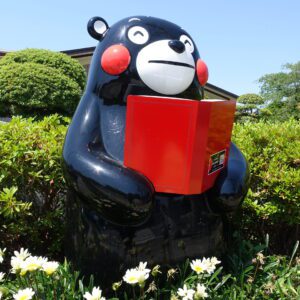
5. Shohinken
Next, I enjoyed the Japanese garden at Shohinken in front of the “Yatsushiro Municipal Museum”. Shohinken is a daimyo garden built in 1688 by Naoyuki Matsui, the owner of Yatsushiro Castle, and is a national scenic spot.
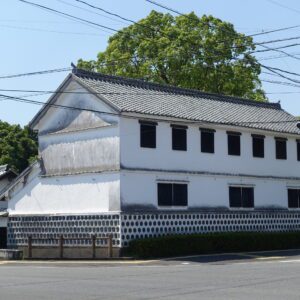
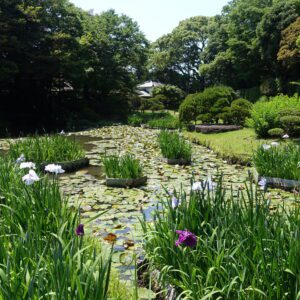
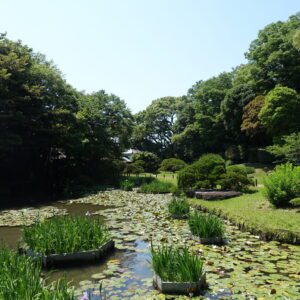
Higo Japanese irises were just beginning to bloom. The only exception is the Higo Japanese irises of Shohinken, which were allowed to be transplanted by the full moon party.

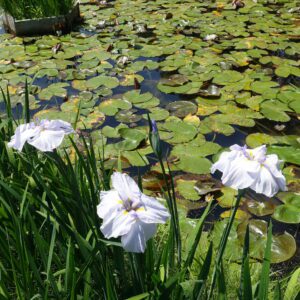
The current owner of the Matsui family still lives in Shohinken. Therefore, we cannot tour the house.
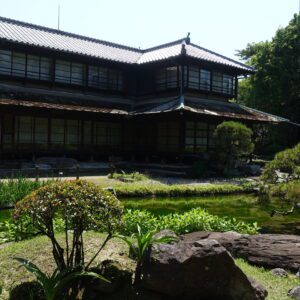
Admission: Adults Yen 500, elementary and junior high school students Yen 250
6. Yatsushiro Castle Ruins / Yatsushiro-gu
I went to the Yatsushiro Castle Ruins near Shohinken. It is designated as a national historic site as “Yatsushiro Castle Ruins and Yatsushiro-gu”.
Yatsushiro Castle was completed in 1622. It was extremely unusual for two castles to be found in the same clan after the Law of One Castle per Province (1615). It is generally accepted that the reason why the existence of two castles (Kumamoto Castle and Yatsushiro Castle) was allowed in the Kumamoto Domain is to prepare for the Satsuma Domain and Hitoyoshi Domain. The main castle of Yatsushiro Castle had a large castle tower on the 5th floors and a small castle tower on the 2nd floors.
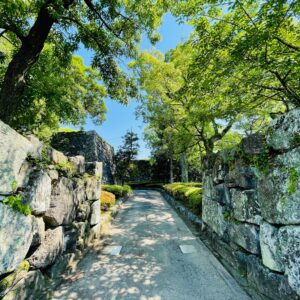

Yatsushiro-gu was founded in 1884. Located on the site of Yatsushiro Castle, Prince Kaneyoshi, the prince of Emperor Go-Daigo, is the main deity. He fought against the Ashikaga army in Kyushu. It is one of the 15 Kenmu Chuko shrines, whose main shrines are the imperial family and military commanders of the Southern Court who contributed to the new Kenmu Restoration. The 15 Kenmu Chuko shrines also includes Yoshino Jingu Shrine, whose main deity is Emperor Go-Daigo, and Minatogawa Shrine, whose main deity is Masashige Kusunoki.

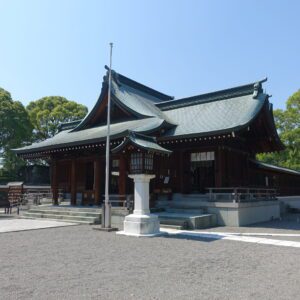
7. Ryuo Shrine
I happened to find Ryuo Shrine on the way from Yatsushiro Castle Ruins to Shunkoji Temple. It is about 5 minutes by bicycle (1.5km) from the Yatsushiro Castle Ruins.
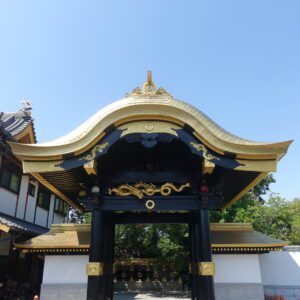
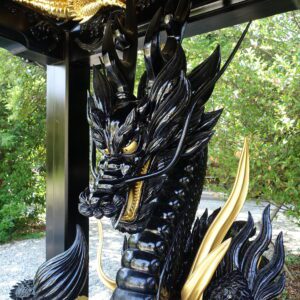
Ryuo Shrine is rare as a shrine and is made only in black and gold. It seems to be a “spiritual hot spot in Yatsushiro” that many celebrities are visiting.

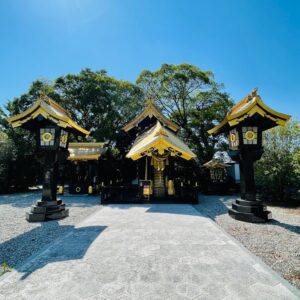
Originally, I like the calm shrines that are unique to Japan, but I thought that such a strange shrine would be nice once in a while. I didn’t know the existence of Ryuo Shrine at all, and I was surprised to find it by chance.

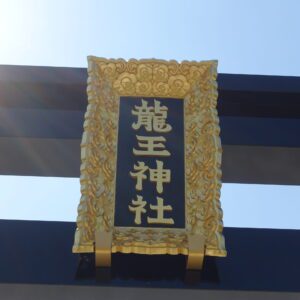
8. Shunkoji Temple
Next to Ryuo Shrine, I went to Shunkoji Temple. It was about 10 minutes by bicycle (2.7km). Shunkoji is a family temple of the Matsui family, the owner of Yatsushiro Castle. This land became a battlefield in the Satsuma Rebellion in 1877, with bullet holes left in places. Shunkoji is a tangible cultural property designated by Yatsushiro City.


Hydrangea was beautifully blooming in the precincts of Shunkoji Temple. Hydrangea is one of my favorite flowers.
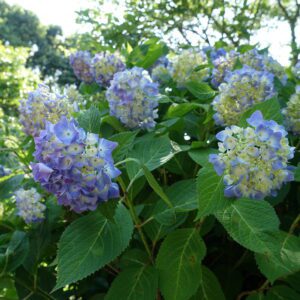
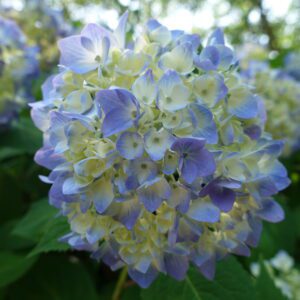
We have to climb a fairly steep staircase to get to the Matsui family’s graveyard. There were many dead leaves in front of the graveyard, and the surroundings were very quiet and felt a little creepy.
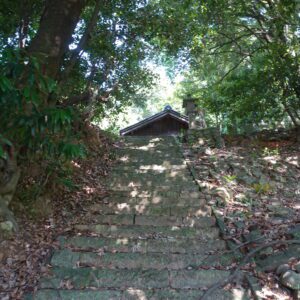
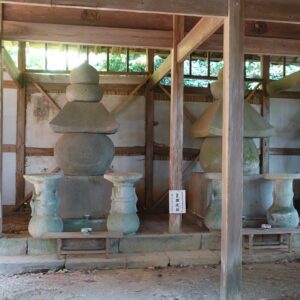
9. Yatsushiro Shrine (Myoken shrine)
As the last place for sightseeing in Yatsushiro, I went to Yatsushiro Shrine (Myoken Shrine). It was less than 5 minutes (1.1km) by bicycle from Shunkoji Temple to Yatsushiro Shrine (Myoken Shrine). Yatsushiro Shrine (Myoken Shrine) is said to be one of the three major Myoken in Japan, along with Soma Myoken in Fukushima Prefecture and Nose Myoken in Osaka Prefecture.
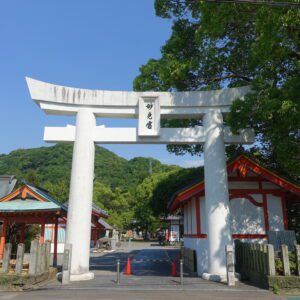
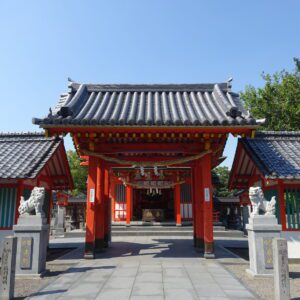
Myoken religion was introduced to Japan as a type of Buddhism by combining The Bodhisattva religion, which originated in India, and the Taoist North Star / Big Dipper religions in China. The Myoken religion was introduced to Japan in the 7th century (Asuka period), and it is a religion from a long time ago. “Mtyoken” means “excellent eyesight” and means a person who sees good and evil and truth well.
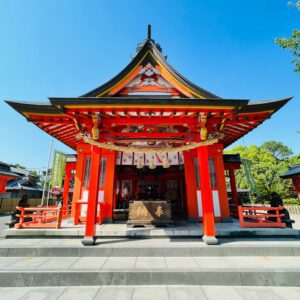
The Yatsushiro Shrine (Myoken Shrine) was built in 795 and is a historical shrine. The Myoken Festival at Yatsushiro Shrine (Myoken Shrine) is one of the three major festivals in Kyushu and is designated as a national important intangible folk cultural property as a “Myoken Festival”. In addition, it is registered as an intangible cultural heritage of the United Nations Educational, Scientific and Cultural Organization (UNESCO) as one of the “Yama, Hoko, Yatai, float festivals in Japan“. The building is a tangible cultural property designated by Kumamoto Prefecture.
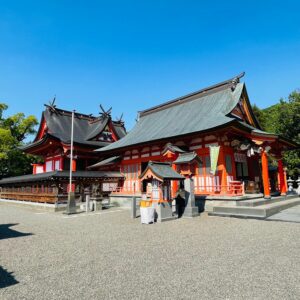
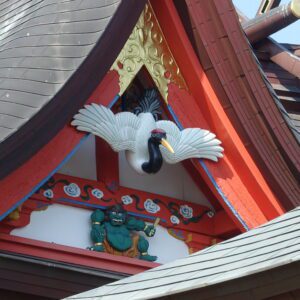
After visiting Yatsushiro Shrine (Myoken Shrine), I returned to Yatsushiro Station. Along the way, I saw Kumamon in a white coat.
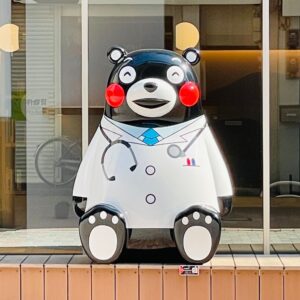
The “Kumamon Train” was stopped at Hisatsu Orange Railway Yatsushiro Station next to JR Yatsushiro Station. First, the light blue “Kumamon Wrapping Train No. 1” arrived, and then the orange “Kumamon Wrapping Train No. 2” arrived and connected with No. 1. The Hisatsu Orange Railway has only No. 1-3 “Kumamon Trains”, and I was very lucky to be able to see Nos. 1 and 2 of them by chance.
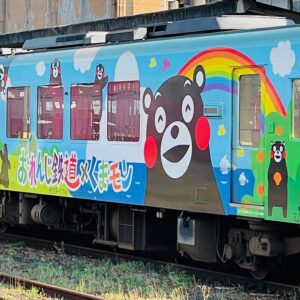
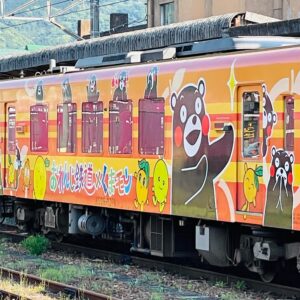
The transportation I used from JR Yatsushiro Station to the “Kappo Ryokan Shoukinkan” where I stayed are as follows.
Depart JR Yatsushiro Station at 16:38, Kagoshima Main Line “bound for Kumamoto”, arrive at Matsubase Station at 16:58
Depart Matsubase Station Street at 17:22, Misumi sanko bus, arrive at Shoukinkan mae at 17:37, total fare is Yen 740
The Shiranui Sea spread out in front of the Shoukinkan. The Shiranui Sea, like the Ariake Sea, was a fairly shallow sea. I didn’t know it at all, but Shiranui is a type of mirage that appears around August 1st of the lunar calendar, and is a type of ghost fire. The light source of Shiranui was found to be fishing fire. However, nowadays, due to the existence of lamps on the opposite bank such as Yatsushiro and the pollution of seawater, it seems that Shiranui can hardly be seen.
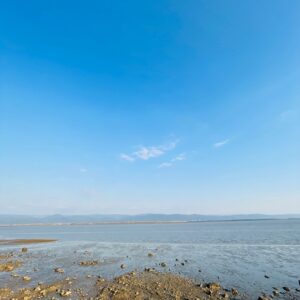
It is said that the “Shiranui type”, Yokozuna (Japanese sumo wrestling champion’s) style, originated from the type of Shiranui Mitsuemon, who was the 11th Yokozuna from Kumamoto prefecture. Shiranui Mitsuemon was born in Ozu Town, Kikuchi District, Kumamoto Prefecture, but it is near Mt. Aso and far from the Shiranui Sea. Rather than taking the name Shiranui from the Shiranui Sea, I think it is better to think of it as inheriting the name of Shiranui Dakuemon, the 8th Yokozuna master of Mitsuemon.
However, there are many sumo wrestlers with the name of Shiranui in front of Shiranui Dakuemon of the 8th Yokozuna, and the first was Shiranui Koemon (the highest rank is No. 3 maegashira). The birthplace of Shiranui Koemon is Higo Province (currently Kumamoto Prefecture), and it seems that the relationship between the sumo wrestlers Shiranui and Kumamoto has continued since the Edo period.
Note: The departure / arrival times, fares, admission fees of transportation, meal fees, etc. listed in the text are as of the time of writing the BLOG. Please check for yourself when you go on a trip as it may change in the future.